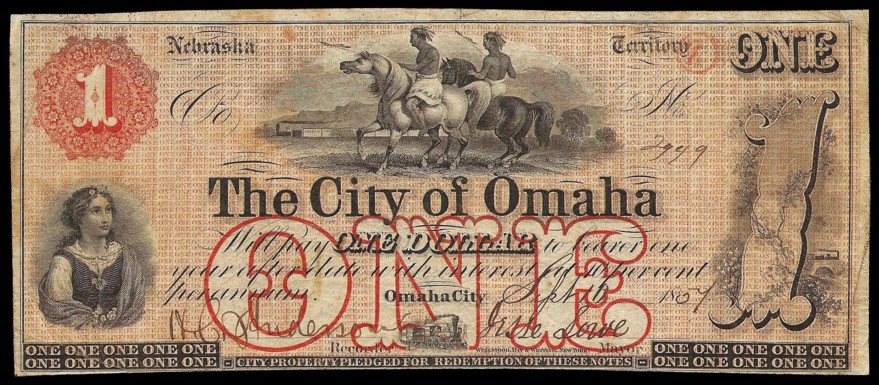Nebraska Territory 1857 $1
The City of Omaha, Nebraska Territory
The City of Omaha was founded in 1854, after a treaty with the Omaha Tribe of Native Americans allowed for the creation of the Nebraska territory. The territory and city had been long in the planning, though. As early as the 1840’s there were pioneers staking lands illegally in the area. This attractive note was issued on September 10, 1857, just three years after the city was founded. These were printed to help build a territorial capitol building. Also in 1857, the first city council meeting was held, and discussions were held on the creation of the Omaha Fire Department. The police department came later, as the Omaha Claim Club (more of a vigilante group) was formed earlier and had control in that realm. Things were looking good throughout the land, with the gold rush just behind them, and the railroads connecting East to West, North to South, and people migrating west, the railroads were bringing people and business to the cities throughout the country, and even the world. So when Omaha decided to issue banknotes, it was probably a pretty great idea.
That’s when it hit – right when things were looking rosy. It turns out that the railroad industry experienced a type of stock bubble, and in July of 1857 they seemed to have their peak. In August of 1857, the oldest flour company in the US went under, and that’s right when things started to go bad. The failure of the N.H. Wolfe Flour company started a bit of a panic in the stock market, and by August, the Ohio Life Insurance and Trust company announced that it was no going to fail as well. This is worse than it sounds at first, as they were also a large banking firm which had large amounts of its holdings in mortgage loans. This of course made people worried and there was a run on the banks, which started to close.
This was about to get worse, as the railroads had been losing value, several large railroad companies failed as well. This had an effect on the price of grain, which slowed the expansion of farmers into the west. This had an effect of land prices falling, which would of course depreciate the value of banknotes backed by city land holdings.
Well, it was certainly more widespread than just Omaha. It was actually felt throughout the country, mostly in the Northern States and Territories where railroads had been expanding their reaches more. Omaha survived, of course, but as a nation recovered, President James Buchannan tried to get Congress to pass an act to cause the forfeiture of any bank’s charter that stopped paying in specie, or precious metal coinage. Buchannan also advocated for banks to adhere to a tighter hold on their issuance of notes and to keep them backed at one-third specie to banknote issue, and to suspend backing by bonds or other assets, such as municipal lands, as this note was.
Despite his efforts, Buchannan’s ideas did not hold, and banks continued on issuing as they did before. But not for too long; there was a civil war looming in the not too distant future that was about to change the way this nation’s money was issued, and bringing an end to the ‘wildcat’ banknotes.

